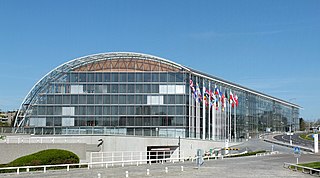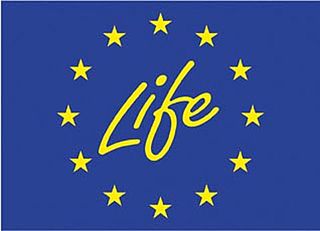Sources
| | This article about the European Union is a stub. You can help Wikipedia by expanding it. |
The European Agricultural Guarantee Fund (EAGF) consumes a large part of the general budget of the European Union. It finances direct payments to farmers under the Common Agricultural Policy (CAP), as well as measures to regulate the common markets such as intervention and export refunds under both the CAP and the Common Fisheries Policy (CFP).
The EAGF and the European Agricultural Fund for Rural Development (EAFRD), which finances the rural development programmes of the Member States, were set up on 1 January 2007 following Council Regulation (EC) No 1290/2005 of 21 June 2005 on the financing of the CAP. They both (along with the earlier established Financial Instrument for Fisheries Guidance) replaced the European Agricultural Guidance and Guarantee Fund (EAGGF), which had been set up by Regulation No 25 of 1962 on the financing of the CAP (as amended by Regulation (EEC) No 728/70.
The fund is administered by the European Commission and the Member States, the Fund Committee consisting of representatives of the Member States and of the commission.

The European Investment Bank (EIB) is the European Union's investment bank and is owned by the 27 Member States. It is the largest multilateral financial institution in the world. The EIB finances and invests both through equity and debt solutions companies and projects that achieve the policy aims of the European Union through loans, equity and guarantees.

The Common Agricultural Policy (CAP) is the agricultural policy of the European Union. It implements a system of agricultural subsidies and other programmes. It was introduced in 1962 and has since then undergone several changes to reduce the EEC budget cost and consider rural development in its aims. It has however, been criticised on the grounds of its cost, its environmental, and humanitarian effects.

The Common Fisheries Policy (CFP) is the fisheries policy of the European Union (EU). It sets quotas for which member states are allowed to catch each type of fish, as well as encouraging the fishing industry by various market interventions. In 2004 it had a budget of €931 million, approximately 0.75% of the EU budget.
England Rural Development Programme is the instrument by which the UK Department for Environment, Food and Rural Affairs (Defra) fulfills its rural development obligations in England, as set out by the European Union. It is derived primarily from Council Regulation European Union Regulation No. 1257/1999 and the related successive implementing Commission Regulations.
The UK rebate was a financial mechanism that reduced the United Kingdom's contribution to the EU budget in effect since 1985. It was a complex calculation which equated to a reduction of approximately 66% of the UK's net contribution – the amount paid by the UK into the EU budget less receipts from the EU budget. Based on a net contribution of €11.7 (£9.6) billion in 2016, the UK Treasury estimated the 2017 rebate amounted to €6.6 (£5.6) billion reducing the ultimate UK contribution for the 2017 budget to €10.4 (£8.9) billion. Although the rebate was not set in the EU treaties, it was negotiated as part of the Multiannual Financial Framework (MFF) every seven years and had to be unanimously agreed.

The European Structural and Investment Funds are financial tools governed by a common rulebook, set up to implement the regional policy of the European Union, as well as the structural policy pillars of the Common Agricultural Policy and the Common Fisheries Policy. They aim to reduce regional disparities in income, wealth and opportunities. Europe's poorer regions receive most of the support, but all European regions are eligible for funding under the policy's various funds and programmes. The current framework is set for a period of seven years, from 2021 to 2027.
The Committee on Agriculture and Rural Development (AGRI) is a committee of the European Parliament.

The Directorate-General for Agriculture and Rural Development is a Directorate-General of the European Commission. The DG AGRI is responsible for the European Union policy area of agriculture and rural development. The work of the DG AGRI is closely linked with the Common Agricultural Policy (CAP).

The Multiannual Financial Framework (MFF) of the European Union, also called the financial perspective, is a seven-year framework regulating its annual budget. It is laid down in a unanimously adopted Council Regulation with the consent of the European Parliament. The financial framework sets the maximum amount of spendings in the EU budget each year for broad policy areas ("headings") and fixes an overall annual ceiling on payment and commitment appropriations.

The budget of the European Union is used to finance EU funding programmes and other expenditure at the European level.

The Commissioner for Agriculture is a member of the European Commission. The post is currently held by Commissioner Janusz Wojciechowski. The post is in charge of rural issues including most notably the controversial Common Agricultural Policy (CAP) which represents 44% of the EU budget. They also participate in meetings of the Agriculture and Fisheries Council (Agrifish) configuration of the Council of the European Union.
The European Agricultural Fund for Rural Development (EAFRD) is one of the European Structural and Investment Funds which was set up for the financing of Rural Development Programme (RDP) actions by European Union Council Regulation (EC) No 1290/2005 of 21 June 2005 on the financing of the Common Agricultural Policy (CAP).
The European Union Solidarity Fund (EUSF) was founded in 2002. Its objective is to provide assistance to European Union member states when large-scale disasters occur. Catastrophes are considered to be large-scale if the estimated direct cost of damage exceeds 3 billion euro or 0.6% of gross national income of the country concerned. Since its inception, the Fund has provided assistance to member states as a result of 56 disasters including earthquakes, forest fires, drought, storms and floods. According to a European Commission report, Italy and Germany have been the leading beneficiaries of these emergency funds, though in total 23 states have received support.

The LIFE programme is the European Union's funding instrument for the environment and climate action. The general objective of LIFE is to contribute to the implementation, updating and development of EU environmental and climate policy and legislation by co-financing projects with European added value. LIFE began in 1992 and to date there have been five phases of the programme. During this period, LIFE has co-financed some 4600 projects across the EU, with a total contribution of approximately 6.5 billion Euros to the protection of the environment and of climate. For the next phase of the programme (2021–2027) the European Commission proposed to raise the budget to 5.45 billion Euro.

The Agriculture and Fisheries Council (AGRIFISH) is one of the configurations of the Council of the European Union and is composed of the agriculture and fisheries ministers of the 27 European Union member states. Its competencies include the Common Agricultural Policy (CAP) and the Common Fisheries Policy (CFP), among others.

The community-led local development (CLLD) funding approach is a European Union initiative to support the decentralised management of development projects, primarily in rural, but also in coastal and urban areas, by involving relevant local actors, including local organizations and associations, as well as individual citizens. At first it was limited to the rural areas under the name LEADER. The approach is regularly evaluated, and also discussed widely in academic literature on local economic and social development.

The Spanish Agricultural Guarantee Fund is an autonomous agency of the Government of Spain, attached to the Ministry of Agriculture, Fisheries and Food, whose main mission is to ensure that the funds from the European Agricultural Guarantee Fund (EAGF) and the European Agricultural Fund for Rural Development (EAFRD) of the Common Agricultural Policy (CAP) assigned to Spain are strictly applied to achieve the objectives of this policy.
The European Maritime, Fisheries and Aquaculture Fund (EMFAF), one of the five European Structural and Investment Funds, is the financial instrument financing the structural policy pillar of the Common Fisheries Policy of the European Union. It was previously known as the Financial Instrument for Fisheries Guidance (FIFG), the European Fisheries Fund (EFF) and the European Maritime and Fisheries Fund (EMFF). The total budget for 2021-2027 is €6.108 billion.